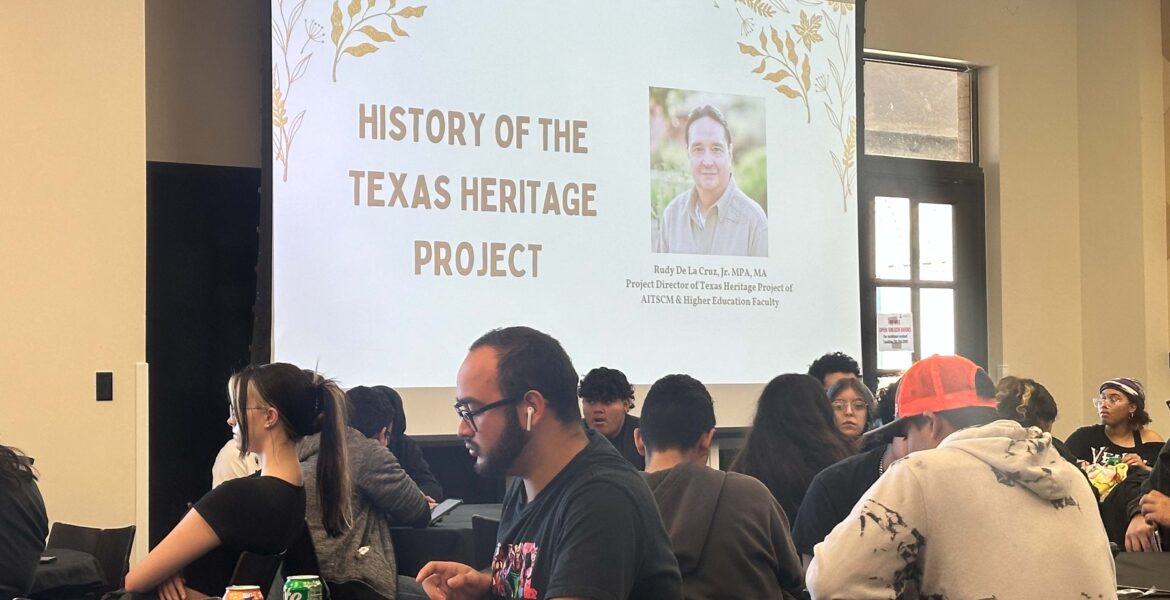Students and guests of different ethnicities at Texas A&M University-San Antonio learned that their family may have heritage connections to Native Americans at a panel discussion hosted Nov. 15 on campus.
Three scholars were invited to speak on a panel and share their knowledge of the project.
The panelists included Rudy De La Cruz, Jr, director of the Texas Heritage Project of American Indians in Texas at the Spanish Colonial Missions and Higher Education Faculty; Dr. Francis X. Galán, associate professor of history at A&M-San Antonio and Leslie Sitz Stapleton, head of archives and special collections at A&M-San Antonio.
The speakers addressed a room of about 65 students, faculty and staff in the Central Academic Building’s Vista Room and 31 people on Zoom as part of the A&M-San Antonio American Indians in Texas at the Spanish Colonial Missions (AITSCM) event.
“Exploring the Texas Heritage Project and American Indians in Texas at the Spanish Colonial Missions” focused on showcasing never-seen family artifacts of the South-Central Texas Region.
“To let people know we’re not extinct, we’ve just been called by different names: Mexican Americans, Latinos but that we’re still here regardless of the political borders that have crossed us, right,” De La Cruz Jr. said. “We remain and are contributing to society in every fashion.”
De La Cruz, Jr. expressed the importance of the legacy and history of American Indian cultures to be honored from the families who reside in the community.
The Heritage Project started in 1994.
De La Cruz, Jr.’s. inspiration for the project came from his uncle, the Rev., Hector De La Cruz. “You are not Mexican,” the Rev., De La Cruz said, “You’re an Indian from Coahuiltecan and I don’t want you to ever forget that fact.”
De La Cruz Jr. encouraged attendees to research their family history and find the importance of their ancestors.
“My family upbringing really influenced what I did in life,” De La Cruz Jr. said.
De La Cruz Jr. said the harvesting of history originated from collecting the oldest artifacts from the oldest families’ names throughout the San Antonio areas.
Collecting these artifacts was made possible by the help of many people in the community. Including the A&M-San Antonio Archives.
In collaboration with the university’s archives, pictures and artifacts were displayed for viewing by the attendees.
“Without family history what is there?” Stapleton said. “It makes all the rest of history have meaning when you already know your own family history.”
Eight depictions of preserved history circled the Vista Room. These images included San Antonio families dating back generations.
The images featured family history such as weddings, baptisms and first communions.
“Preserving history is important for your children and grandchildren,” said Richard Garay, Elder of the Payaya Tribe. “They won’t know where they came from unless the older people tell them.”
Garay explained that the formal preservation is not only important for history, but also for generations of families who cannot remember detailed information.
“What’s bad now is that most of the older people don’t know who’s in these pictures,” Garay said. “And the older, older people, many of them don’t have many letters in their head. They can’t read or write the names of their family.”
The panelists viewed the images alongside the attendees. Each explained how the images made them feel and why they should be cherished.
“I would hope that in a spiritual level it awakened something inside,” said Anua Reyes, a graduate student from the University of Hawaii. “That when they go outside they don’t just see trees. They start to see their living ancestors.”
For more information and resources about how you can begin preserving your own family history visit aitscm.org.
To learn more about upcoming First-Year Experience Common Speaker events follow the Office of First Year Experience on Instagram @tamusafye or email Myrna Garza at myrna.garza@tamusa.edu






